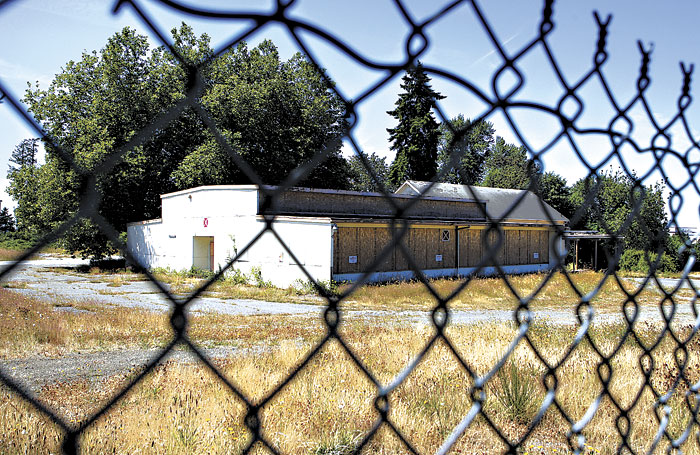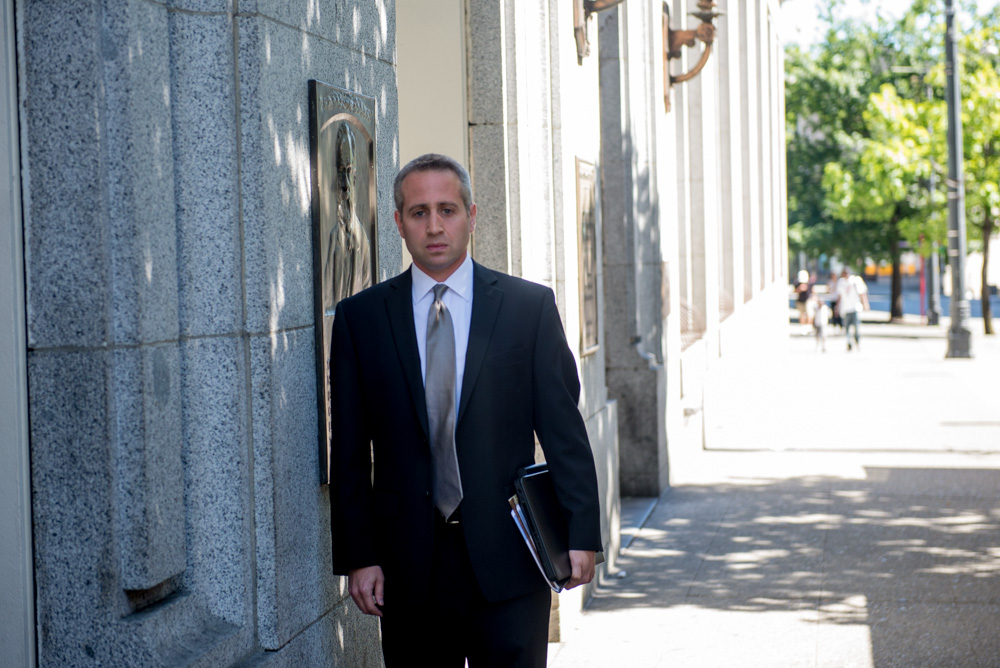Passengers flying low enough during their approach to Seattle-Tacoma International Airport might catch a glimpse of the charred husk that used to be the Angle Lake School. After it was decommissioned by the Highline School District in 1975, the once-proud elementary school at South 28th Avenue and 192nd Street served as SeaTac’s first City Hall and, during its declining years, office space.
The property on which it sits was purchased by the Port of Seattle in 2004 with the intent of building an additional cargo maintenance facility at the site. Five years later, the land still sits vacant, save for the now-decrepit collection of buildings that once made up the school. Much of the school burned down last summer in what authorities have since ruled was arson. Afterwards, the Port boarded up what remained and erected a security fence, which, according to neighbors, hasn’t done much to keep local teens or the occasional vagrant from taking up temporary residence.
The Port owns approximately 4,000 acres of land in King County, 191 of which, including the Angle Lake site, are located in five separate parcels surrounding Sea-Tac Airport. Some sit vacant and overgrown with grass, and residents complain of illegal dumping and drug use at the sites.
Kim Carson, a SeaTac resident and neighborhood representative with ACORN of King County, says that efforts to press the Port to speed up its development of the properties have been met with failure. “We’ve told them we want something done, but the most that ever happens is someone comes out to cut the grass,” complains Carson.
The sites have also become an issue in the current Port Commissioner elections. At an ACORN-sponsored debate held last month at Seattle’s South Park Community Center, Carson says that all the candidates were asked about the sites, but few had any answers. Rob Holland, a candidate for Position 3 on the Port Commission, would prefer that the Port got out of the commercial real estate development business altogether. “The Port does not have a history of success when it comes to developing properties that are not related to aviation or water,” he explains. “But if we do have these properties that are underutilized, it presents an opportunity to bridge the credibility gap with those communities by building something useful.”
Furthermore, a report released last week by the Municipal League of King County sharply criticizes the Port of Seattle’s real estate development strategy, stating that the Port’s stewardship of its holdings has thus far been an “economic disappointment.”
Back in 2001, the Port Commission, after consulting with a small army of stakeholders, adopted Harbor Development Strategy 21, a revamped set of policies that would help guide port operations in the new century. The report lays out a three-pronged strategy for managing the Port’s commercial real estate holdings, the second of which commits the Port to contributing to regional growth by acquiring and then preparing properties for development. It’s only after considering local and federal land-use regulations, market conditions, and community needs that any decision is made, says Port spokesperson Charla Skaggs.
As evidenced by the Angle Lake site, that process can sometimes take years. Development, says Skaggs, does not operate according to a set timeline. However, the guidelines call for an annual reassessment of all the Port’s real estate holdings, which, according to the Municipal League’s report, is only now taking place.
While the Strategy 21 guidelines addressed the complexity of managing the Port’s real estate portfolio, they did not address the realities of developing properties near the airport. Here, says Skaggs, the Port is largely beholden to Federal Aviation Administration regulations which require FAA approval of any plan to sell, convert to airport use, or otherwise develop property within the safety buffer zone around the airport.
“What can seem like dragging your feet is really us adhering to the strict regulations that govern land use,” explains Skaggs. “The question for us is always: How do we develop properties that benefit the community without endangering the safety of airport operations?”
In attempting to develop the properties, adds Skaggs, the Port also has to contend with the various municipalities that surround the airport, all of which have their own land-use plans.
In August 2007, Port CEO Tay Yoshitani created a Real Estate Division to manage the Port’s properties and update its guidelines for doing so. Shortly thereafter, the bottom dropped out of the real estate market, torpedoing efforts to develop properties like the 89 acres of Port-owned land in Des Moines that were set to become the site of a business park. The Port was negotiating a lease with a private development firm when the economy tanked. Negotiations between the Port and the city of Des Moines to continue the project are ongoing.
The Port has been losing money on its commercial real estate properties since 2005; according to the agency’s own budget forecast, the Real Estate Division will suffer a $4.3 million shortfall in 2009. “The reality is that this is not a good environment for real estate development,” says Skaggs. “We continue to work on what we would call pre-development, to make sure that we’re ready to go once the market becomes healthy again.”
The implications of these delays, says Bruce Carter, chairman of the committee that wrote the Municipal League’s report, go beyond the Port’s bottom line. “If there’s no lease, that means there’s no economic activity on the land, which means there are no jobs, no rent paid to the Port, and no money paid back to the state,” explains Carter. “It’s a three-fold lose.”
All is not doom and gloom, however, at least not from the Municipal League’s perspective. The report, while rapping the Port for the slow pace of its development efforts, applauds Yoshitani’s recent efforts to speed things up. In February the Port’s CEO installed Joe McWilliams as Managing Director of the new Real Estate Division. McWilliams and his staff are working to develop new strategies to manage the Port’s portfolio, claims Skaggs.
“The overarching idea is that, clearly, business as usual doesn’t work any longer,” says Brad Meacham, chair of the Municipal League. “While we’ve been studying the organization, they’ve been making changes. I think we’re encouraged by the reforms that we’ve seen, and hope that the report helps accelerate them.”
When residents like Kim Carson will see those changes realized remains an open question. In June, the Real Estate Division submitted to the FAA its latest land-use plan for the sites in the airport buffer zone. A response is not expected until later this fall.
“We’ve waited for years for something that will be good for the community to appear,” says Carson. “They’re still empty, just sitting there being ugly.”








